Key heritage features
Distinctive features of major building styles can help you identify the significant elements of your property of the period which it was built in.
Heritage publications which have been completed for some of these distinctive features can be explored below:
Fences
Fencing is one of the most important elements in the presentation of your house and the character of the street. The design of your fence should complement the style of your house. This can be achieved by building your fence of materials and colours that relate to the materials and design changes with different architectural periods and styles.
If you are lucky enough to have early photographs of your house, these might provide valuable clues for the original design of the fence that was built for your house. A general guideline of the most common types of fencing found in the area for different house styles is given below.
| Style |
Fence type |
| Victorian Cottage |
Timber picket |
| Woven wire |
| Victorian Italianate |
Iron palisade |
| Victorian Gothic |
Iron palisade up to 1200mm high |
| Timber picket fence up to 900mm high |
| Woven wire |
| Federation |
Masonry pier and panel up to 1200mm high including a brick base up to 450mm high |
| Timber Picket (square topped) |
| Solid masonry |
| Inter-War |
Brick pier and panel |
| Solid masonry |
 Iron Palisade
Iron Palisade
Palisade fences have panels of cast iron pickets with spiked or shaped tops, connected by a horizontal rail and set into a sandstone or rendered masonry base. Dressed sandstone posts are located at corners and gateways and where necessary, intermediate posts are used.
Palisade fences are usually between 1200 and 1500mm high. On some larger sites, a palisade fence could be up to 1800mm high.
 Retaining walls
Retaining walls
Retaining walls are used on steep sites, sometimes topped with a metal palisade or picket fence. They are usually incorporated in to the garden design. Typical materials are either sandstone or face brick.
Solid masonry fences are designed with panels of solid masonry up to 1,200mm (although usually lower) between slightly taller piers. The materials are usually face brick or sandstone, depending on the materials used in the design of the house. Solid masonry fences are usually much lower for Inter-War and Post WWII housing with panels up to 450mm high.
 Timber picket fences
Timber picket fences
Timber picket fences are built with timber pickets fixed to horizontal rails spanning between posts. The spacing of the pickets for Victorian period fences are usually the same as the width of the picket. Some Federation picket fences have closer spaces between the pickets.
The pickets for fences to Victorian houses usually have a shaped top. Common shapes for pickets in Victorian fences include pointed, half round, and acorn. Picket fences for Federation houses are more likely to have square tops and chamfered edges. Posts for picket fences are often shaped in a design that relates to the shape of the pickets. Federation period houses might also have pickets combined with brick piers and low brick panels. Gates for picket fences are made of either matching pickets or might be framed with boarded timber panels. The height of picket fences varies with most being between 900 and 1200mm high, usually depending on the length of the street boundary.
 Woven Wire
Woven Wire
Variations of woven wire fencing were used in most periods. Wire mesh was fixed to a simple frame of post and rails to provide a simple fence. Earlier examples are rare and often have the wire finished in decorative loops at the top. Later examples use chain wire with timber framing. Privacy was usually achieved by planting a hedge behind the wire mesh. Woven wire fences are rarely more than 900mm high.
Post and Rail

Characterised by timber or metal tubing generally consisting of top, intermediate and/or bottom rails between regularly spaced posts. Common in houses from the beginning of the 20th Century up to the end of WWII.
Painting and rendering
The Inner West local government area is fortunate to contain a large number of older buildings which play a role in defining the area’s character and identity. Many of these buildings retain much of their original architectural finishes and detailing. It is important that the original features of these buildings are retained wherever possible, as they represent elements of their historic and aesthetic significance.
These details help to tell a story about the evolution of building technologies and design ideals over time and contribute to our shared history. For example, exposed brick facades are a key characteristic of many Federation (c.1890-1915) buildings made possible through technological change. During the Federation period an innovation in the brick making process allowed for the production of hard burnt dry pressed bricks of an even colour range. Previously, bricks had often been rendered to hide their uneven colour and irregular sizing. As a result, external brick were kept exposed and began to play an integral role in the design and aesthetic qualities of these buildings.
Exposed face brick and sandstone facades and fences continue to contribute to the character and heritage significance of many buildings within the local government area. Painting or rendering these surfaces may seem like a simple change, but it can seriously undermine the heritage value of a property. It may also lead to additional maintenance issues as covering these materials inhibits their ability to respond to environmental factors. Once bricks and sandstone are painted or rendered, it is almost impossible to return them to their natural state without some irreversible and permanent damage.
Decorative face brickwork on facade of inter-war residential flat building.

Render being removed off a building’s original sandstone facade.
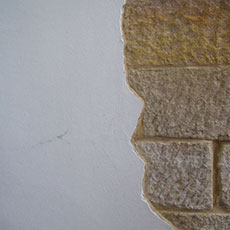
Attempts made to remove paint from an original face brick facade through sandblasting. Note that traces of the paint are still visible.

Period style houses - Ashfield
Ashfield was first established in the Victorian period, when the gold rushes were stimulating new prosperity and great population growth in Australia. The building of the railway from Sydney to Parramatta, which included Ashfield station, was the stimulus for the first important wave of settlement. Most of the early houses in Ashfield displayed what has become known as the Victorian Georgian style — they were built in much the same manner as the simple houses of Georgian Britain. Only a handful of such houses remain. Some dwellings
were made a little more decorative, with details such as those seen during Britain’s Regency period. As the suburb grew, the cast-iron “lace” filigree satisfied the desire for more ornamentations. Many variations of this widespread style could be seen.
As Australia moved towards federation, more varied styles appeared, some of them illustrating the wish for more dramatic, less formal designs. These Federation styles, showing the influence of America as well as Britain, also employed the better materials, like excellent
brick and terra cotta tiles. And machine production that could lathe- tum and fret-saw timber in elaborate patterns. The Queen Anne and Arts-and-Crafts styles typify this phase of residential architecture.
The Inter-War period was probably Ashfield’s most prolific for home building. One great influence was the bungalow form that originated in California and spread throughout Australia. With its wide roofs and ample verandahs it suited the local climate better than many other forms. New materials such as concrete now supplemented older materials like corrugated iron.
Below are descriptive illustrations of house facades showing just a few of the main styles of architecture that can be seen in the houses of Ashfield. They form a part of the urban tapestry of the suburb — its heritage.
 Victorian Filigree
Victorian Filigree
This style appeared in single houses in semi- detached pairs and terrace rows, either single- storeyed or two-storeyed. Its name comes
from the use of cast-iron ‘lace’ or filigree decoration.
1. Chimney with moulded top
2. State or corrugated metal roof
3. There may be a parapet instead of eaves
4. Balcony roof has a skillion or bull nose profile
5. French doors to balcony
6. Cast iron filigree. There may be a simi- lar ‘lace’ ensemble on the ground floor.
7. Fire walls. Where there are no firewalls the balcony may be cantilevered or supported on posts.
8. Stucco facade
Note: The ground floor fenestration is usually asymmetrical, the upper storey is symmetrical.
 Victorian Italianate
Victorian Italianate
This style employed vaguely Italian Classical details such as quoining (embellished wall corners ) and the colonnaded ‘loggia’ (what we call the verandah). It is always asymmetrical in form and generally free-standing. The style began with large houses such as ‘Glentworth’ (the Convent of the Good Shepherd) in Victoria Street, and was adapted to much humbler dwellings. Some variants include a single-fronted and two storeyed types.
1. Fairly steep hipped roof of slates or corrugated metal
2. Skillion or bull nosed verandah roof
3. Chimney with moulded top
4. Stucco facade walling
5. Gable-fronted side wing, usually with decorated barge boards
6. Facetted bay with double-hung window sashes. The window heads were often stilted arched.
7. Verandah usually decorated with cast iron filigree
8. Pseudo-tower motif
 Victorian Regency
Victorian Regency
So-called because of the carry-over of Regency detailing into the Victorian period. Houses of this style always have symmetrical facades and simple decoration.
1. Symmetrical facade
2. Brick walling with painted stucco finish. Many early houses of this style had stone walls
3. Hipped roof of medium pitch, covered in slates or corrugated metal. Many were originally shingled.
4. Verandah typically with three bays, with timber posts and simple curvilinear valences
5. Verandah roof usually corrugated metal, often curved profile
6. Double-hung sash or casement windows or sometimes French doors. Openings sometimes had moulded architraves
 Federation Queen Anne
Federation Queen Anne
The asymmetrical form continued into the Federation period and beyond. Houses were almost always single-storeyed and featured face brick and wither slate or terracotta roofs. The cast iron embellishment of earlier times gave way to machine-cut timber decoration.
1. Fairly steep hipped roof of slates or tiles, often with crested ridges and terminals. Rafter feet often exposed.
2. Some houses have a gablet ventilator
3. Face brickwork, usually tuck– pointed
4. Gabled wing at one side of the house. Sometimes the gable projects so far as to require supporting brackets
5. Projecting bay with casement windows
6. Decorative timber posts, brackets and frieze
7. Bracketed window hood
8. Decorative apron below windowsill
9. Timber gable screen
10. Brick chimney with terracotta pots
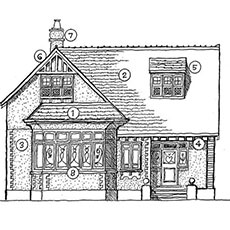 The Arts and Crafts Style
The Arts and Crafts Style
Houses of this style were built in the federation and Inter-War periods and, as the name implies, usually employed finely crated finishes and details in timber or roughcast rendering and in features such as lead lights. Massing is asymmetrical or picturesque.
1. Asymmetrical facade arrangement, often incorporating a window bay
2. Conspicuous roofs of terracotta tiles
3. Walling usually displays face brick- work and roughcast render. Corners may be emphasized by ‘quoining’
4. Rafter feet usually exposed. Eaves are often emphasised with timber decoration
5. Attic spaces often have a skillion dormer
6. Gable screen or infill
7.Chimney with roughcast detailing and terracotta pots
8. Windows usually have a casement sashes with leaded glass, often with Art Nouveau motifs
 California Bungalow
California Bungalow
As the name implies, this style originated in America. In the Inter-War period it became one of the most common Australian housing styles. The asymmetrical form emphasised the increasing informality of domestic life at this time.
1. Comparatively low-pitched gable ensemble. Roofs may be shingles, tiles or corrugated metal
2. Panelled gable infill, usually with ventilator
3. Face brick walling in stretcher bond, indicating cavity-wall construction. Many houses have roughcast render as well
4. Taper-cut or spiky barge boards. Rafter feet are also often exposed. Eaves overhangs are often wide
5. Tapered pylons or colonettes supporting verandah beam
6. Project in window with hood and casement windows. Windows are often glazed with lead lighting
7. Main window often has a shingled skirt below the sill
 Sydney Bungalow
Sydney Bungalow
This house form became widespread, particularly in Sydney, in the late Inter-War years and continued to be built after World War II. It was uncomplicated in massing and often incorporated Art Deco motifs typical of the time. Straw-coloured or cream brickwork was popular.
1. Facade usually asymmetrical but sometimes symmetrical
2. Medium pitched roof usually of terracotta tiles
3. Cavity brickwork in stretcher bond, often with raked bed joints
4. Boxed eaves
5. Soldier-course brick lintels
6. Double-hung windows, often with horizontal glazing bars
7. Brick piers, often with recesses or fins and corbelled caps
8. Art Deco details such as geometric brick patterning and leadlight designs
Period style houses - Marrickville
The distinctive features of the major building styles in Marrickville are shown below to help you identify and appreciate the period of your house.Not all buildings are exact examples of these styles. Many are based on pattern book designs with changes being made by individual builders.
When proposing to make alterations to your house it is important to understand how your building relates to your allotment, the landscape, to your neighbours and the street. Understanding dominant building types and styles in the area and how these buildings relate to their subdivision patterns to form distinctive streetscapes, is important to understanding the heritage significance of the area.
The former Marrickville Council prepared guidelines or Development Control Plans (DCPs) to guide you in making decisions about what additions are appropriate to your style of house.
House styles in Marrickville
Marrickville's older buildings are important because they show a variety of styles from a wide range of periods which reveal the area’s cultural history. The most important of these buildings are protected as heritage items and are listed in the Marrickville Local Environmental Plan (LEP) 2001. Important groups of buildings which can reveal the many different aspects of Marrickville’s cultural history have been mapped as draft Heritage Conservation Areas and are also identified in the Marrickville LEP 2001.
Understanding the stylistic features of the major building types is important when making decisions about maintaining your home, restoring your home, reinstating lost details or making additions.
There are a number of architectural styles used by architects and builders in each historic period.
Colonial 1788-1840
 |
| Colonial regency |
Victorian 1840-1890

|
|

|
Victorian Filigree
|
|
Victorian Georgian
|
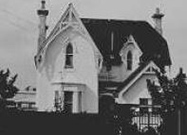 |
|
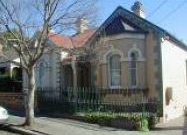 |
Victorian Gothic
|
|
Victorian Italianate
|
Federation 1890-1915

|
|
 |
Federation Bungalow
|
|
Federation Arts and Crafts
|
Federation 1890-1915

|
|

|
Federation Queen Anne
|
|
Federation Filigree
|
Interwar and later 1915-1940

|
|

|
Californian Bungalow
|
|
Ocean Liner Style
|

|
|
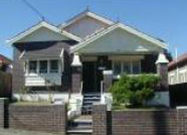
|
Georgian Revival Style
|
|
Interwar Bungalow
|

|
|
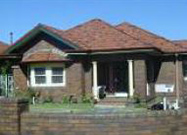
|
Spanish Mission
|
|
1930s Bungalow
|
Dormer Windows - Marrickville
The content below was originally written by Kate Napier and Charlotte Norris in 2012.
Individual style, traditional form
The word dormer derives from the Latin dormire which means to sleep. Dormer windows were traditionally a means to provide light and ventilation for bedrooms, or dormitories, in the roof space. Dormer windows were typically added to a building to meet the needs of an increasing number of occupants, or they were part of the original design being both economical and picturesque. These same qualities are motivating contemporary households to add dormer windows and maximise the use of existing space in the roof.
Reference point
In Australia dormer windows most commonly feature in 19th and early 20th century buildings. Dormer windows with classical revival and rustic qualities also less commonly appear throughout the 20th century in buildings where nostalgia is a stylistic feature eg: ‘Inter-War Old English’, ‘Post War American Colonial’, and ‘Post Modernism’. However after the Federation era (post 1915), most 20th century building styles did not feature dormer windows.
In the former Marrickville Local Government Area, original 19th and early 20th century dormer windows are not common, and many of those have undergone later modifications. The few early dormers which remain reasonably intact are depicted in this guide as a design reference.
By broadening knowledge and appreciation of the proportion, details and appropriate placement of traditional dormer windows, it is anticipated that improvements in contemporary and historic dormer design and construction will ensue.
Victorian Dormer Windows
Original Victorian (1840-1890) dormer windows are most common in Petersham, Camperdown, Stanmore and Newtown. Often they are Mid to Late Victorian in style with Federation (1890-1915) detail edging in. The Early Victorian dormer window most readily demonstrates the intrinsic features and therefore it is a useful base model to study.
Classical inspiration
The proportions and details of a typical Victorian dormer are inspired by the Classical temple front (this is also true of the typical Victorian mantelpiece). The Early Victorian dormer is based on the Greek temples. Towards the middle and end of the Victorian era dormers became more ornate and elaborate, and stylistically closer to a Roman temple. Federation detailing in the Queen Anne, Anglo Dutch, Filligree and Free Classical styles retained elements of the vertically proportioned Victorian form whilst Arts and Crafts and Bungalow became more horizontal.
The Hellenic Temple of Hephaestus (415 BC) Athens, with its Doric columns is an example of the type of temple proportion and detail that inspired these two Early Victorian style dormer windows.
The Roman Temple of Artemis (150 AD) Jordan, exhibits the more ornate carving and geometric composition typical of Roman architecture, evident in these two Mid - Late Victorian style dormer windows.
Essential features of the Victorian Dormer Window
- No gutters
- Solid “cheeks”, usually weatherboard
- No roof or rafter overhang
- Wide timber “pilasters” (25% width of window) with a block timber base
- A timber “lintel” over the window
- A triangular or curved pediment above the lintel, and roof shaped to suit
- A vertically proportioned double hung timber framed window (height:width ratio = 3:2)
- Usually corrugated steel sheeting on the roof, and sometimes slate
- A position subordinate to the ridge line (high point at least 300mm below the ridge measured vertically)
- A scale which is modest, and not ‘top heavy’ in relation to the building below

This Victorian style dormer window in Balmain (above) is an excellent example of the Early Victorian Classical aesthetic. The curved roof example in Annandale (below left) retains the typical proportions, whilst the finials (spire crowning the gable) in the Glebe examples (below centre and right) show a progression toward Federation detailing within the Classical Victorian form.

Appropriate Position
As a rule Victorian dormer windows are usually symmetrically placed in the roof.
A single, centrally located dormer window is appropriate on a single storey building front, where the facade contains one door and one window.

On a double fronted, single storey building with a central door, and a window on each side, two dormer windows would be appropriate, symmetrically positioned, or directly above the windows on the floor below.
A multi storey Victorian house would accommodate the same number of dormers as there were doors, or windows, on the façade directly below or less if the roof shape does not permit.
Dormer Windows in the former Marrickville Local Government Area
Federation (1890-1915) dormer windows are less common in the former Marrickville Council area than Victorian. This is perhaps because the Federation style building is typically manifest in a single storey, detached but modest house, on a larger suburban site. Therefore perhaps there was less pressure and/or financial capacity to utilise the roof as habitable space.
Where Federation dormer windows do occur in the area, they are typically horizontal in proportion, and often asymmetrically positioned in the roof. The appropriate detail for proposed Federation dormer windows will generally need to be based on models outside the former Marrickville Council area and/or stylistic details contained within the subject base building.

Inlaid street and place names
In the 1930s red lettered names were inlaid within footpaths and gutters as part of a Depression relief program. They are currently protected by their location within a Heritage Item or a Heritage Conservation Area under Marrickville Local Environmental Plan (LEP) 2011.
Marrickville Development Control Plan (DCP) 2011 specifically identifies the names as having heritage significance and requires that they be conserved: Part 8.3.2.1 Public Domain Elements: C5 – Concrete panels with inlaid street names must be retained in-situ for a distance of at least 500mm from the lettering.
State Environmental Planning Policy (Infrastructure) 2007, Part 2, Division 1, 14: requires that Council be notified in writing of works proposed to Heritage Items and Heritage Conservation Areas; that an assessment of the heritage impact be provided, and that Council’s response is taken into consideration.
Inlaid names are typically located on footpaths and gutters at road intersections or park entrances.
